The Higher Order Thinking and Reasoning Routines (HOTR)
Nationwide, students have challenges with content acquisition and critical thinking. Content Enhancement Routines are a powerful solution. The Higher Order Thinking and Reasoning (HOTR) Routines—Concept Comparison, Teaching Cause and Effect, Teaching Cross-Curricular Argumentation, Scientific Argumentation, Teaching Decision Making, and Question Exploration) —are useful to content teachers working on building students’ higher order reasoning and thinking skills and extending their understanding. These Content Enhancement Routines help students engage in the critical skills of higher order thinking and reasoning required by state standards.
New research article:
Bulgren, J., Minarik, D., & Washburn, J. (2024). Higher order thinking and reasoning through primary source document analysis. In S. Waring (Ed.), Teaching with primary sources for cultural understanding, civic mindedness, and democracy (pp. 47-63). Teachers College Press
- HOTR PD SLIDE SETS from author JAN BULGREN
-
A#2 Allignment of HOTR Routines with Reasoning Standards
A#3 Similarities across HOTR Routines to facilitate tracking and learning
B#1 Introduction to the Cross Curricular Argumentation Routine (CCAR)
B#2 Allignment of CCAR with Standards Across Content Areas
B#3 Expanding Learning with the Cross Curricular Argumentation Routine (CCAR)
C#1 Demystifying Reasoning and Deconstruction Complex Questions
C#2 Building Bridges from other CERs to HOTR routines
C#3 Scaffolds for gradual introduction of complex HOTR routines
How can CERs support Higher Order Thinking? (Florida SPDG resource)
2022 Florida Update: Exploring Higher Order Thinking and Reasoning Routines
Watch Video Passcode: 6G?yq=+6FG
HOTR Webinar 2: Engaging Students in HOTR and Writing with CERs ppt
Presentation from 2023 Florida Update (Sarah Davidson): Strategies for PDers to Increase Implementation of HOTR Routines
- HOTR SIM Website
-
These Content Enhancement Routines help students engage in the critical skills of higher order thinking and reasoning required by state standards.
Teaching Cause and Effect Routine
Teaching Cross-Curricular Argumentation Routine
- Graphic: Organizational CERS + HOTR CERS
-
Authors: Craig Wisniewski, Terri Lent
Purpose: The purpose of this resource is to show the progression from the Content Enhancement Routines for organizing content to support student exploration of topic and details (Unit Organizer Routine and FRAMEing Routine) to the Higher Order Thinking Routines (Question Exploration, Concept Comparison, Cause and Effect, Scientific Argumentation/Cross Curricular).
Suggestions for Use: A SIM Professional Developer may want to insert this slide into their presentation when introducing a HOTR CER or print this slide as a handout. Additionally, if a SIM PD'er is working with a teacher(s) who utilize the FRAMEing Routine with fidelity, this is an excellent resource to support that individual teacher's growth in utilizing HOTR.This resource is 1/2 in a series with the FRAME and HOTR being an additional resource.
- FRAME and HOTR
-
Authors: Terri Lent, Craig Wisniewski
Purpose: The purpose of this resource is to show how each specific component of the FRAMEing Routine supports a specific Higher Order Thinking Routine.
Suggestions for Use: A SIM Professional Developer may want to insert this slide into their presentation when introducing a HOTR CER or print this slide as a handout. Additionally, if a SIM PD'er is working with a teacher(s) who utilize the FRAMEing Routine with fidelity, this is an excellent resource to support that individual teacher's growth in utilizing HOTR.
This resource is 1/2 in a series with CER and HOTR being an additional resource.
- HOTR Overview for Content Specialists
-
Authors: Chris Schnieders, Debbie Fleming
Purpose: Slides for PDers to use when presenting importance of Higher Order Thinking and Reasoning Content Enhancement Routines to Content Specialists that are familiar, and easy to edit and reorganize.
Suggestions for Use: Slides for overview of HOTR routines; includes goals, examples of strategies, devices, instructional procedures, and expanded supports in content areas. - Example HOTR Classroom Activity for Cause and Effect Guide - Sue Woodruff
-
Andrea is the 9th grade ELA teacher in a very small high school in rural Ohio. The high school is literally sitting in the middle of soybean and corn fields. Only about 25% of their kids go on to higher education, but they are working on that. The entire staff of the HS is really good in the high school (not so great in the middle school.) Many of these teachers have been doing Content Enhancement for several years, so that is why we wanted to add the higher order reasoning routines for them to try out. I was able to visit Andrea’s 9th grade at-risk class where she did this Cause & Effect Routine in a masterful way. Most of the boys leave after her class to go to the county vocational school. I think there were about 20 kids in the class. Here’s how it went:Leading up to 3/31 Lesson:On prior days to prepare for doing this routine, the class read two relatively short articles that were synopsizes of two Supreme Court cases. They also did a small group assignment where they were assigned a case, and the small groups had to research and create a poster that answered several guiding questions. Students put the posters on the walls around the classroom, and then they were asked to do a gallery walk to familiarize themselves with the basics of the other cases. They were to jot down some notes about each case.
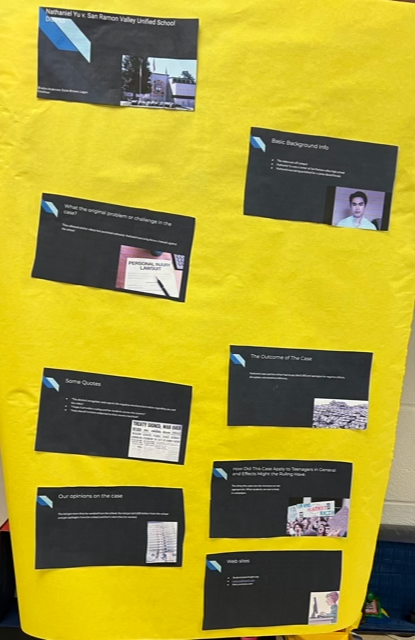
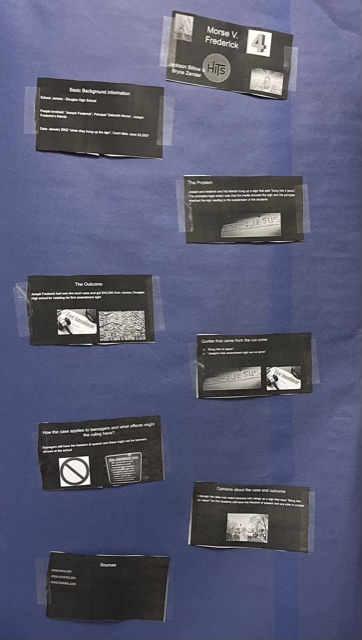
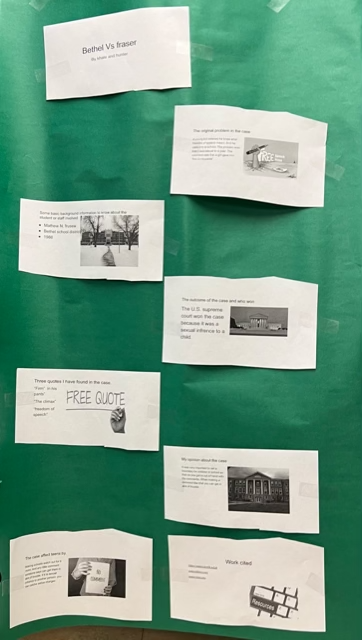
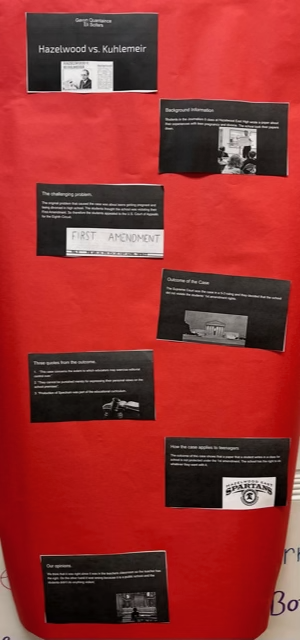
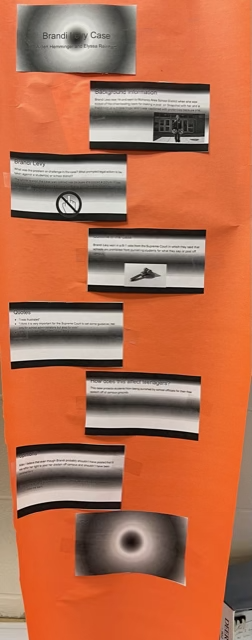 1st 10 minutes:Students were asked to look over their notes and visit any posters that they hadn’t had time to look at yet.Following 30 minutes:Andrea gave each student a guide with the following prompts:
1st 10 minutes:Students were asked to look over their notes and visit any posters that they hadn’t had time to look at yet.Following 30 minutes:Andrea gave each student a guide with the following prompts: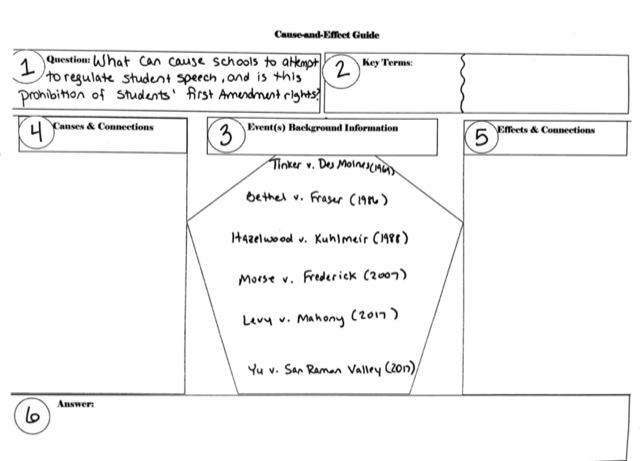 Andrea masterfully went through the routine with the students. The students were extremely engaged as each of these cases related to high school students taking an issue to the Supreme Court. The content was genius. This work is preparing students for writing an essay. Andrea is also a master at the writing strategies, so that gets embedded once the kids start writing which is planned for next week. The guide was completely co-constructed except for the answer. This class is shorter than the regular bell schedule because these are the voc kids. She moved quite quickly through the answer with them in order to finish, but I am sure she was going to spend a little more time today debriefing the experience.Here is a copy of the completed Cause & Effect Diagram:
Andrea masterfully went through the routine with the students. The students were extremely engaged as each of these cases related to high school students taking an issue to the Supreme Court. The content was genius. This work is preparing students for writing an essay. Andrea is also a master at the writing strategies, so that gets embedded once the kids start writing which is planned for next week. The guide was completely co-constructed except for the answer. This class is shorter than the regular bell schedule because these are the voc kids. She moved quite quickly through the answer with them in order to finish, but I am sure she was going to spend a little more time today debriefing the experience.Here is a copy of the completed Cause & Effect Diagram: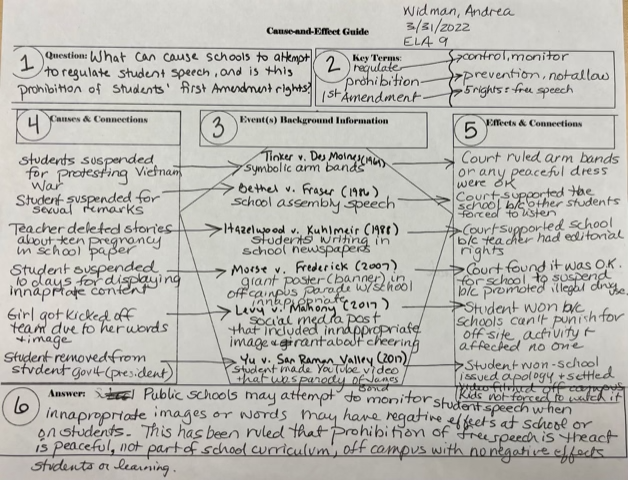 It was such an enjoyable learning experience!
It was such an enjoyable learning experience!
- Crosswalk Between SIM CER Guidebook Formats (HOTR)
-
The purpose of this resource is to ease the transition from using the familiar Edge CER guidebooks to the format of the CRL guidebooks on Higher Order Thinking and Reasoning (HOTR) CER. A SIM Professional Developer may want to insert this slide into their presentation when introducing a HOTR CER or print this slide as a handout. For more detailed information about the similarities and differences between guidebook formats, please read this crosswalk.
- HOTR Choice Guide
-
Use the information in the chart to identify a HOTR routine that may address an instructional need in your course of study.
- Lesson Plan: Legal and Ethical Internet in Information Technology, Cross-Curricular Argumentation
-
Author: Charlotte Slaughter, Library/Media
Purpose: Avoiding plagiarism through summarizing, citation, note taking, researching. Analyze topics in “Opposing Viewpoints” , Choose a topic, select sources, begin notetaking and develop a claim, start an essay
Lesson Plan: Legal and Ethical Internet in Information Technology, Cross-Curricular Argumentation
